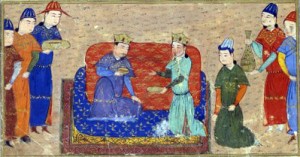In a recent study by researchers from Columbia University and West Virginia University and published in the Proceedings of National Academy of Sciences, the team concluded with a theory, that the weather might have helped the Mongol army conquer the largest contiguous empire in history.
 About eight hundred years ago, Genghis Khan and his sons ruled most of modern-day Russia, China, Korea, southeast Asia, Persia, India, the Middle East and eastern Europe after Mongols ruthlessly conquered all these territories.
About eight hundred years ago, Genghis Khan and his sons ruled most of modern-day Russia, China, Korea, southeast Asia, Persia, India, the Middle East and eastern Europe after Mongols ruthlessly conquered all these territories.
Historians for a long time have believed that the Mongols’ fast horses and brilliant cavalry tactics were two of their major advantage, but what other factor could have helped their rapid rise and overcoming so many other territories and countries? Well, the answer could have been climate change or good weather to be exact according to the team of scientists.
Researchers have been working in Mongolia since 1995 and they have been looking at many ecological factors including tree-rings. Annual rings of many species reflect rainfall or temperature in predictable ways. These can be read like books; and trees in the driest, harshest sites like this are exquisitely sensitive to rain, live to extraordinary ages, and leave trunks that may stand for centuries after they die. In addition, researchers have been looking at grass production, while reasoning that the mild weather could have brought an unusual boom in grass production, and therefore affecting favorably livestock numbers including camels, yaks, cattle, and sheep. So, it looks like that the Mongolian army and Mongol cavalryman had many warhorses and animals for food that could have enabled fighters to travel fast and long. Researchers are also looking at lake-bottom sediments, soil and all the date will eventually go into a computer modeling program at University of Alabama.
Researchers also propose that the Mongols could have suffered a climatic setback, too: a cold snap in 1260-1266 and subsequent return to more normal weather in Mongolia appears to coincide with the decline of Karakorum, whose heyday lasted only 30 years. The empire soon fragmented. Today, barely anything of Karakorum remains but a giant stone turtle that once marked one of its corners.
Excerpts from PastHorizonspr.com by permission. http://www.pasthorizonspr.com/index.php/archives/03/2014/rise-of-genghis-khan-linked-to-mongolian-climate-change















